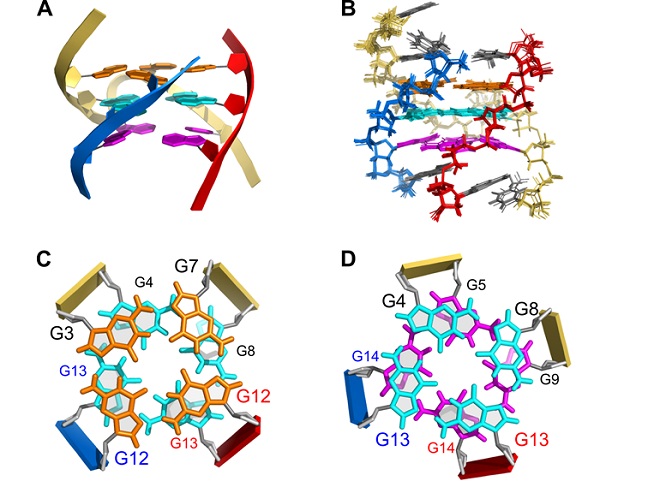
Using solution-state Nuclear Magnetic Resonance (NMR) technology, a group of scientists led by Prof. ZHANG Na from Hefei Institutes of Physical Science (HFIPS) of Chinese Academy of Sciences (CAS) recently discovered a novel reassembly process for G-quadruplexes (GQs) through a new type of reaction called Hoogsteen pairing-based Strand Displacement Reaction (Hoogsteen SDR) recently.
Conventional Watson-Crick SDR involves the displacement of one strand from a double-stranded DNA or RNA helix by a single-stranded homologous invading strand, completely based on the principle of the Watson–Crick base-pairing rule. GQs, which are noncanonical secondary structures formed by guanine-rich nucleic acid fragments, can exist in different forms like monomeric or intermolecular assemblies. Well-folded GQs are highly stable and resistant to SDR with other guanine-rich strands.
"Our work is the first to describe the spontaneous reassembly of G-quadruplex via Hoogsteen pairing-based SDR and present a novel NMR solution structure of heteromeric tri-GQ with a unique mode of two probes vs one target." said Professor ZHANG Na.
In this research, the team focused on a specific taget sequence of Tub10 d(CAGGGAGGGT), which was a DNA fragment from the G-rich promoter region of the human β2-tubulin gene.
In a K+ solution, the Tub10 sequence self-folds into a parallel homomeric dimolecular GQ (di-GQ) with high thermal stability. The scientists utilized Hoogsteen pairing-based SDR and introduced a pair of short G-rich probes (P1 d(TGGGA)) to invade the Tub10 GQ. Through this process, they were able to reassemble the starting di-GQ into a novel parallel heteromeric trimolecular GQ (tri-GQ) of Tub10/2P1.
This research not only provided the first NMR solution structure of a discrete heteromeric tri-GQ but also revealed a unique mode of recognition between two probes and one target among G-rich DNA fragments. The short G-rich probe P1 demonstrated higher specificity for GQ targets compared to traditional antisense probes. Furthermore, P1 served as a model system by effectively capturing the G-rich target Tub10 from a Watson-Crick duplex formed when Tub10 hybridized with its complementary strand.
These findings opened up new possibilities for the reassembly of GQs and offered insights into the interaction between G-rich DNA fragments, according to the team.
This work was supported by National Key Research, Development Program of China and National Natural Science Foundation of China.

Figure 1. Schematic illustration of the spontaneous Hoogsteen pairing-based strand displacement reaction between one homo-dimolecular GQ target and dual G-rich invading probes at room temperature, yielding the final product of heteromeric trimolecular GQ. (Image by ZHANG Na)

Figure 2. NMR solution structure of the heteromeric tri-GQ of Tub10/2P1. (Image by ZHANG Na)